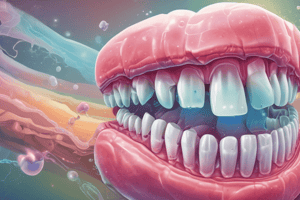Podcast
Questions and Answers
What is the shape of the pit and fissure lesion in cross-section?
What is the shape of the pit and fissure lesion in cross-section?
- Circular
- V-shaped (inverted cone) (correct)
- Conical
- U-shaped
What is the weakest part of tooth structure?
What is the weakest part of tooth structure?
- Cementum
- Enamel
- Dentinoenamel junction (correct)
- Dentin
How do pit and fissure caries progress when they reach the DEJ?
How do pit and fissure caries progress when they reach the DEJ?
- They spread vertically into the pulp
- They stop progressing
- They spread laterally along the DEJ (correct)
- They progress rapidly into the dentin
What is the shape of the lesion in cross-section in smooth enamel surfaces?
What is the shape of the lesion in cross-section in smooth enamel surfaces?
Why are root surfaces susceptible to dental caries?
Why are root surfaces susceptible to dental caries?
What is a characteristic of root caries lesions?
What is a characteristic of root caries lesions?
What is a factor that affects the progression of the carious lesion?
What is a factor that affects the progression of the carious lesion?
Why does the cementum covering the root surface provide little resistance to caries attack?
Why does the cementum covering the root surface provide little resistance to caries attack?
What is the direction of the apex of the V-shaped lesion in pit and fissure caries?
What is the direction of the apex of the V-shaped lesion in pit and fissure caries?
What is the shape of the area of origin in smooth enamel surfaces?
What is the shape of the area of origin in smooth enamel surfaces?
Flashcards are hidden until you start studying
Study Notes
Plaque Retention and Susceptible Sites
- Any site on the tooth surface that favors plaque retention and stagnation is prone to caries
- Sites that particularly favor plaque retention include:
- Enamel pits and fissures on occlusal surfaces of molar and premolar teeth
- Buccal pits of lower molars and palatal pits of upper molars and maxillary incisors
- Proximal enamel smooth surfaces just cervical to the contact area
- The enamel at the cervical margin of the tooth, especially in patients with gingival recession
- The margins of restorations, particularly where there is a wide gap between the restoration and the tooth or where the restoration overhangs the margin of the cavity
Classification of Dental Caries
- Based on tooth surface site:
- Pit and fissure caries
- Smooth surface caries
- Root caries
- Based on tooth surface integrity:
- Non-cavitated or incipient caries
- Cavitated
- Based on rate of progression:
- Acute caries
- Chronic caries
- Arrested caries
- Based on whether the caries lesion is new or under restoration:
- Primary caries
- Secondary or recurrent caries
- G.V. Black classification:
- Class I: Caries affecting the pits and fissures of posterior teeth
- Class II: Caries affecting the proximal surfaces of posterior teeth
- Class III: Caries affecting the proximal surfaces of anterior teeth, without involving the incisal edge
- Class IV: Caries affecting the proximal surfaces of anterior teeth, and involving the incisal angle
- Class V: Caries affecting the cervical one-third of facial and lingual surfaces of all teeth
- Class VI: Caries affecting the incisal edges of anterior teeth and cusp tips of posterior teeth
- Limitations of G.V. Black classification:
- Does not include secondary caries
- Does not include root surface caries
- Kidd and Smith classification:
- Based on the anatomic site
- Includes root caries and recurrent caries
- Does not include the size of the lesion
- Graham Mount's classification:
- Based on the cavity size and site
- Does not include root caries or recurrent caries
- Includes the size of the lesion
Clinical Characteristics of the Caries Lesion
- Characteristics of caries lesion vary according to the surface nature on which the lesion develops
- Three clinical sites for caries initiation:
- Pits and fissure surfaces of enamel
- Smooth enamel surface
- Root surface
- Pits and fissure caries:
- High susceptibility to dental caries due to their shape
- Expands as it penetrates into the enamel
- In cross-section, the gross appearance of a pit-and-fissure lesion is an inverted V (cone shaped) with a narrow entrance and a progressively wider area of involvement closer to the DEJ
- The dentinoenamel junction is the weakest part of tooth structure
- When caries reach the DEJ, it spreads laterally along the DEJ and then progresses into dentine in a V-shaped manner
- Smooth enamel surfaces:
- Less favorable site for dental caries than pits and fissure surfaces
- Lesions starting on smooth enamel surfaces have a broad area of origin and a conical, or pointed, extension toward the DEJ
- A cross-section of the enamel portion of a smooth surface lesion shows a V shape (inverted cone) with a wide area of origin and the apex of the V directed toward the DEJ
- Root surfaces caries:
- Root surfaces are susceptible to dental caries when they become exposed to the oral environment
- Exposed as a result of gingival recession
- The root surface is rougher than enamel and readily allows plaque formation in the absence of good oral hygiene
- The cementum covering the root surface is extremely thin and provides little resistance to caries attack
- Root caries lesions have less well-defined margins, tend to be U-shaped in cross-section, and progress more rapidly
Progression of Carious Lesion
- The progression of the carious lesion is variable, depending on:
- The site of origin
- The conditions in the mouth
Studying That Suits You
Use AI to generate personalized quizzes and flashcards to suit your learning preferences.




